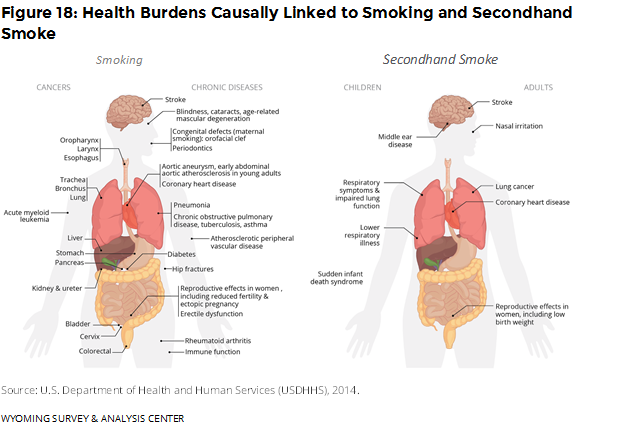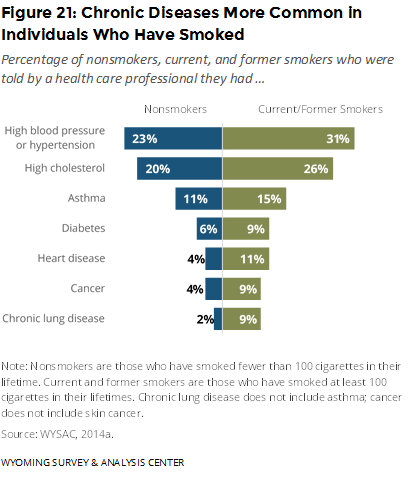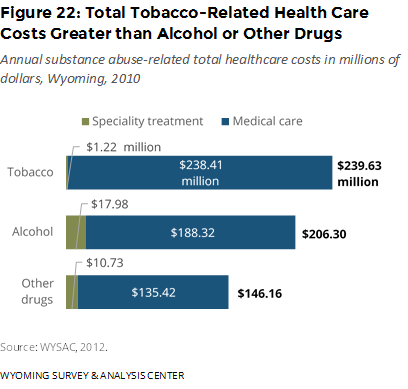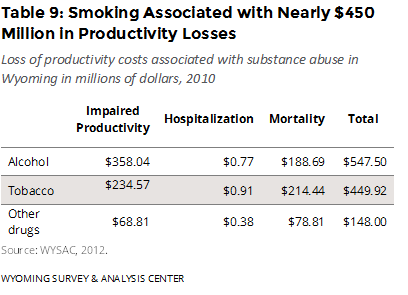Burdens of Tobacco Use
Health B urdens
urdens
Although there is no safe level of exposure to tobacco smoke, greater exposure increases the risk for and severity of chronic disease. Cigarette smoke contains cancer-causing agents and chemicals linked to biological mechanisms that cause cardiovascular diseases, pulmonary diseases, respiratory diseases, and contribute to poor reproductive and dental health. More than 7,000 toxic chemicals comprise cigarette smoke, including ammonia, tar, and carbon monoxide. These chemicals increase the risk for developing several preventable chronic diseases for smokers and those who breathe secondhand smoke (Figure 20; USDHHS, 2014).
Electronic cigarettes are a new tobacco-related product, so research on the contents of their liquid, vapor, and health effects is limited. Currently, the FDA does not have any regulations on the liquids used in electronic  cigarettes or the devices and components. Early studies about the contents of the liquid and vapor show the presence of varying levels of nicotine as well as cancer-causing chemicals such as formaldehyde (American Lung Association, 2015). Overdoses have been reported, including among children, from drinking the nicotine liquid or spilling the liquid on their skin (CDC, 2014). Many of the liquids also contain other chemicals for flavoring, which could be harmful when vaporized and inhaled. Research shows that the use of electronic cigarettes negatively affects lung function (Cressey, 2014).
cigarettes or the devices and components. Early studies about the contents of the liquid and vapor show the presence of varying levels of nicotine as well as cancer-causing chemicals such as formaldehyde (American Lung Association, 2015). Overdoses have been reported, including among children, from drinking the nicotine liquid or spilling the liquid on their skin (CDC, 2014). Many of the liquids also contain other chemicals for flavoring, which could be harmful when vaporized and inhaled. Research shows that the use of electronic cigarettes negatively affects lung function (Cressey, 2014).
Chronic diseases are the leading causes of death and sickness in the United States and Wyoming (Kochanek et al., 2011). Smoking is the leading preventable cause of chronic disease and dea
th in the United States (USDHHS, 2010). Compared to Wyoming nonsmokers (adults who had smoked fewer than 100 cigarettes in their lifetime), current and former smokers (adults who had smoked at least 100 cigarettes in their lifetime) were significantly more likely to have been diagnosed with high blood pressure, high cholesterol, asthma, heart disease, chronic lung disease, diabetes, and/or cancer (the survey item excluded skin cancer, but did not specify any other cancers; Figure 21; WYSAC, 2014a).
Economic Burdens
 In 2010, tobacco-related healthcare cost Wyoming nearly $240 million, including private and public costs, more than alcohol and other drugs (Figure 22; WYSAC, 2012).
In 2010, tobacco-related healthcare cost Wyoming nearly $240 million, including private and public costs, more than alcohol and other drugs (Figure 22; WYSAC, 2012).
Smoking is associated with lost productivity nationally (USDHHS, 2015) and in Wyoming. Tobacco cost the state of Wyoming nearly $450 million in total productivity losses in 2010 (Table 9; WYSAC, 2012).
 Smoking workers are generally less healthy and more costly for employers (USDHHS, 2015). When considering aggregate cost and productivity impacts, Berman et al. (2013) estimated that, on average, a U.S. smoker costs $5,816 more annually than a nonsmoker to employ. Employing smokers is also associated with increased property loss and occupational disease (USDHHS, 2015). Smokers are more likely to be injured at work than nonsmokers (Craig et al. 2006; USDHHS, 2015).
Smoking workers are generally less healthy and more costly for employers (USDHHS, 2015). When considering aggregate cost and productivity impacts, Berman et al. (2013) estimated that, on average, a U.S. smoker costs $5,816 more annually than a nonsmoker to employ. Employing smokers is also associated with increased property loss and occupational disease (USDHHS, 2015). Smokers are more likely to be injured at work than nonsmokers (Craig et al. 2006; USDHHS, 2015).

